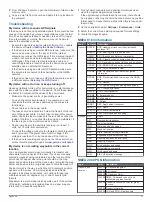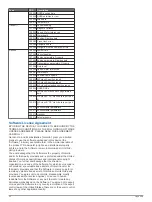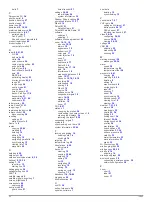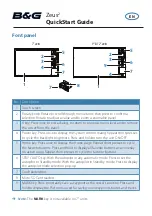
2
From Windows
®
Explorer, open the Garmin\scrn folder on the
memory card.
3
Copy a .bmp file from the card and paste it to any location on
the computer.
Troubleshooting
My device will not acquire GPS signals
If the device is not acquiring satellite signals, there could be few
causes. If the device has moved a large distance since the last
time it has acquired satellites or has been turned off for longer
than a few weeks or months, the device may not be able to
acquire the satellites correctly.
• Ensure the device is using the latest software. If not, update
the device software (
).
• If the device is using an internal GPS antenna, make sure the
device has a clear view of the sky so that the internal
antenna can receive the GPS signal. If it is mounted inside of
a cabin, it should be close to a window so it can receive the
GPS signal. If the device is mounted inside a cabin and
cannot be placed in a location where the device can acquire
satellites, use an external GPS antenna.
• If the device is using an external GPS antenna, make sure
the antenna is connected to the chartplotter or the NMEA
network.
• If the device has more than one GPS antenna source, select
a different source (
).
My device will not turn on or keeps turning off
Devices erratically turning off or not turning on could indicate an
issue with the power supplied to the device. Check these items
to attempt to troubleshoot the cause of the power issue.
• Make sure the power source is generating power.
You can check this several ways. For example, you can
check whether other devices powered by the source are
functioning.
• Check the fuse in the power cable.
The fuse should be located in a holder that is part of the red
wire of the power cable. A 3 Amp fuse is used in this power
cable. Check the fuse to make sure there is still a connection
inside of the fuse. You can test the fuse using a multimeter. If
the fuse is good, the multimeter reads 0 ohms.
• Check to make sure the device is receiving is at least 10
volts, but 12 volts is recommended.
To check the voltage, measure the female sockets 8 (power)
and 2 (ground) of the power cable for DC voltage. If the
voltage is less than 10 volts, the device will not turn on.
• If the device is receiving enough power but does not turn on,
contact Garmin product support at
.
My device is not creating waypoints in the correct
location
You can manually enter a waypoint location to transfer and
share data from one device to the next. If you have manually
entered a waypoint using coordinates, and the location of the
point does not appear where the point should be, the map
datum and position format of the device may not match the map
datum and position format originally used to mark the waypoint.
Position format is the way in which the GPS receiver's position
appears on the screen. Commonly displayed as latitude/
longitude in degrees and minutes, with options for degrees,
minutes and second, degrees only, or one of several grid
formats.
Map datum is a math model which depicts a part of the surface
of the earth. Latitude and longitude lines on a paper map are
referenced to a specific map datum.
1
Find out which map datum and position format was used
when the original waypoint was created.
If the original waypoint was taken from a map, there should
be a legend on the map that lists the map datum and position
format used to create that map. Most often this is found near
the map key.
2
On the chartplotter, select
Settings
>
Preferences
>
Units
.
3
Select the correct map datum and position format settings.
4
Create the waypoint again.
NMEA 0183 Information
Type
Sentence Description
Transmit GPAPB
APB: Heading or track controller (autopilot)
sentence "B"
GPBOD
BOD: Bearing (origin to destination)
GPBWC
BWC: Bearing and distance to waypoint
GPGGA
GGA: Global positioning system fix data
GPGLL
GLL: Geographic position (latitude and longitude)
GPGSA
GSA: GNSS DOP and active satellites
GPGSV
GSV: GNSS satellites in view
GPRMB
RMB: Recommended minimum navigation
information
GPRMC
RMC: Recommended minimum specific GNSS
data
GPRTE
RTE: Routes
GPVTG
VTG: Course over ground and ground speed
GPWPL
WPL: Waypoint location
GPXTE
XTE: Cross track error
PGRME
E: Estimated error
PGRMM
M: Map datum
PGRMZ
Z: Altitude
SDDBT
DBT: Depth below transducer
SDDPT
DPT: Depth
SDMTW
MTW: Water temperature
SDVHW
VHW: Water speed and heading
Receive DPT
Depth
DBT
Depth below transducer
MTW
Water temperature
VHW
Water speed and heading
WPL
Waypoint location
DSC
Digital selective calling information
DSE
Expanded digital selective calling
HDG
Heading, deviation, and variation
HDM
Heading, magnetic
MWD
Wind direction and speed
MDA
Meteorological composite
MWV
Wind speed and angle
VDM
AIS VHF data-link message
NMEA 2000 PGN Information
Type
PGN
Description
Transmit and
receive
059392 ISO acknowledgment
059904 ISO request
060928 ISO address claim
126208 NMEA: Command, request, and
acknowledge group function
126464 Transmit and receive PGN list group
function
126996 Product information
129026 COG and SOG : Rapid update
Appendix
41
Summary of Contents for GPSMAP 7400 Series
Page 1: ...GPSMAP 7400 7600 Series Owner s Manual February 2015 Printed in Taiwan 190 01841 00_0B...
Page 2: ......
Page 51: ......





































